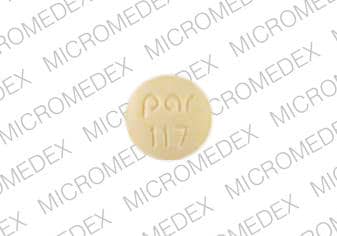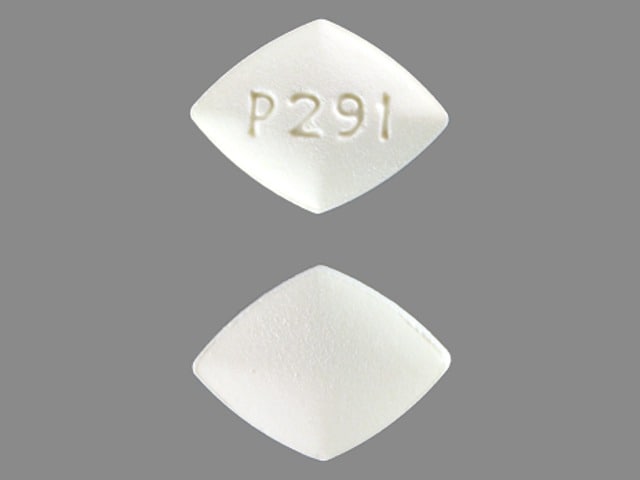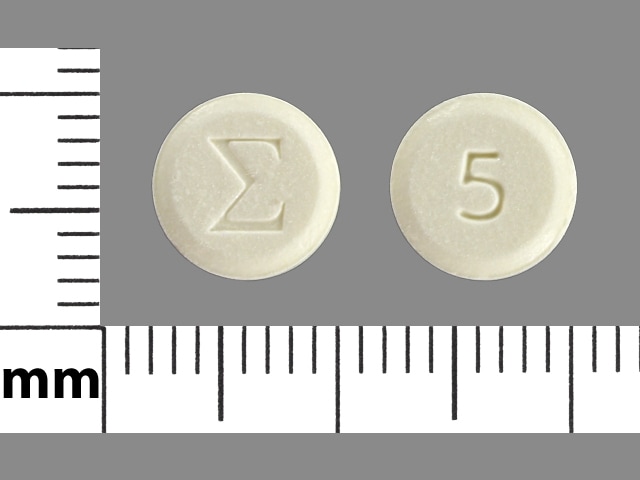Boxed Warning
Hyperkalemia:
Like other potassium-conserving agents, amiloride may cause hyperkalemia (serum potassium levels greater than 5.5 mEq per liter) which, if uncorrected, is potentially fatal. Hyperkalemia occurs commonly (about 10%) when amiloride is used without a kaliuretic diuretic. This incidence is greater in patients with renal impairment, diabetes mellitus (with or without recognized renal insufficiency), and in the elderly. When amiloride is used concomitantly with a thiazide diuretic in patients without these complications, the risk of hyperkalemia is reduced to about 1% to 2%. It is thus essential to monitor serum potassium levels carefully in any patient receiving amiloride, particularly when it is first introduced, at the time of diuretic dosage adjustments, and during any illness that could affect renal function.
Dosage Forms
Excipient information presented when available (limited, particularly for generics); consult specific product labeling.
Tablet, Oral, as hydrochloride:
Generic: 5 mg
Pharmacology
Mechanism of Action
Blocks epithelial sodium channels in the late distal convoluted tubule (DCT), and collecting duct which inhibits sodium reabsorption from the lumen. This effectively reduces intracellular sodium, decreasing the function of Na+/K+ATPase, leading to potassium retention and decreased calcium, magnesium, and hydrogen excretion. As sodium uptake capacity in the DCT/collecting duct is limited, the natriuretic, diuretic, and antihypertensive effects are generally considered weak.
Pharmacokinetics/Pharmacodynamics
Absorption
30% to 90% (Macfie 1981)
Distribution
Vd: 350 to 380 L (Macfie 1981)
Metabolism
Does not undergo hepatic metabolism
Excretion
Urine (~50%; as unchanged drug); feces (~40%)
Onset of Action
Within 2 hours; Peak effect: 6 to 10 hours
Time to Peak
Serum:3 to 4 hours
Duration of Action
~24 hours
Half-Life Elimination
Normal renal function: 6 to 9 hours; renal impairment (CrCl <50 mL/minute): 21 to 144 hours (George 1980)
Protein Binding
Minimal (Macfie 1981)
Use: Labeled Indications
Heart failure or hypertension: Counteracts potassium loss induced by other diuretics in the treatment of hypertension or heart failure; usually used in conjunction with more potent diuretics such as thiazides or loop diuretics
Note: Potassium-sparing diuretics are not recommended for the initial treatment of hypertension (ACC/AHA [Whelton 2017]).
Use: Off Label
Ascitesbyes
Data from a small randomized controlled trial in patients with nonazotemic cirrhosis treated with amiloride or potassium canrenoate support use of amiloride (although less effective than potassium canrenoate) for management of ascites in patients who do not tolerate treatment with spironolactone.
Contraindications
Hypersensitivity to amiloride or any component of the formulation; presence of elevated serum potassium levels (>5.5 mEq/L); if patient is receiving other potassium-conserving agents (eg, spironolactone, triamterene) or potassium supplementation (medicine, potassium-containing salt substitutes, potassium-rich diet) except in severe and/or refractory cases of hypokalemia; anuria; acute or chronic renal insufficiency; evidence of diabetic nephropathy. Patients with evidence of renal impairment (blood urea nitrogen [BUN] >30 mg/dL or serum creatinine >1.5 mg/dL) or diabetes mellitus should not receive amiloride without close, frequent monitoring of serum electrolytes and renal function.
Dosage and Administration
Dosing: Adult
Hypertension (alternative agent), heart failure (to limit potassium loss): Oral: Initial: 5 mg once daily; titrate as needed to 10 mg daily in 1 or 2 divided doses; may increase dose in increments of 5 mg daily up to 20 mg daily in 1 or 2 divided doses. Usual dosage range in hypertension: 5 to 10 mg daily in 1 or 2 divided doses (ACC/AHA [Whelton 2017]). Note: Typically used as combination therapy with thiazide diuretics to prevent hypokalemia; minimal antihypertensive effect as monotherapy.
Ascites (off-label use): Initial: 10 mg twice daily. If no response, increase every 4 days in increments of 10 mg twice daily to a maximum dosage of 30 mg twice daily (Angeli 1994). American Association for the Study of Liver Diseases (AASLD) guidelines recommend a dosage range of 10 to 40 mg daily (AASLD [Runyon 2012]; EASL 2010).
Dosing: Geriatric
Geriatric patients also show decreased clearance of amiloride; use with caution. Refer to adult dosing.
Dosing: Pediatric
Hypertension: Limited data available: Children and Adolescents: Oral: Initial: 0.4 to 0.625 mg/kg/dose once daily; maximum daily dose: 20 mg/day (NHBPEP 2004; NHLBI 2011)
Edema: Limited data available: Children and Adolescents: Oral: 0.625 mg/kg/day divided every 12 to 24 hours; maximum daily dose: 20 mg/day (Van der Vorst 2006)
Nephrogenic diabetes insipidus, congenital: Limited data available: Infants, Children, and Adolescents: Oral: 0.3 mg/kg/day in divided doses 3 times daily or 20 mg/1.73 m2/day in combination with hydrochlorothiazide; dosing based on a retrospective descriptive analysis (n=30, age range: 1 month to 40 years), two pediatric case series (n=4 and n=5), and a case report. (Kirchlechner 1999; Kliegman 2016; Knoers 1990; Uyeki 1993; Van Lieburg 1999)
Extemporaneously Prepared
A 1 mg/mL oral suspension may be made with tablets. Crush ten 5 mg tablets in a mortar and reduce to a fine powder. Add small proportions up to 20 mL of Glycerin BP or Glycerin, USP and mix to uniform paste; mix while adding sterile water in incremental proportions to almost 50 mL; transfer to a calibrated bottle, rinse mortar with sterile water, and add quantity of sterile water sufficient to make 50 mL. Label “shake well” and “refrigerate”. Stable for 21 days.
Nahata MC, Pai VB, and Hipple TF, Pediatric Drug Formulations, 5th ed, Cincinnati, OH: Harvey Whitney Books Co, 2004.
Administration
Oral: Administer with food or meals to avoid GI upset.
Dietary Considerations
Do not use potassium-containing salt substitutes.
Storage
Store at 20°C to 25°C (68°F to 77°F). Avoid freezing or excessive heat. Protect from moisture.
AMILoride Images
Drug Interactions
Alfuzosin: May enhance the hypotensive effect of Blood Pressure Lowering Agents. Monitor therapy
Amifostine: Blood Pressure Lowering Agents may enhance the hypotensive effect of Amifostine. Management: When amifostine is used at chemotherapy doses, blood pressure lowering medications should be withheld for 24 hours prior to amifostine administration. If blood pressure lowering therapy cannot be withheld, amifostine should not be administered. Consider therapy modification
Ammonium Chloride: Potassium-Sparing Diuretics may enhance the adverse/toxic effect of Ammonium Chloride. Specifically the risk of systemic acidosis. Consider therapy modification
Amphetamines: May diminish the antihypertensive effect of Antihypertensive Agents. Monitor therapy
Angiotensin II Receptor Blockers: May enhance the hyperkalemic effect of Potassium-Sparing Diuretics. Monitor therapy
Angiotensin-Converting Enzyme Inhibitors: Potassium-Sparing Diuretics may enhance the hyperkalemic effect of Angiotensin-Converting Enzyme Inhibitors. Monitor therapy
Antipsychotic Agents (Second Generation [Atypical]): Blood Pressure Lowering Agents may enhance the hypotensive effect of Antipsychotic Agents (Second Generation [Atypical]). Monitor therapy
Barbiturates: May enhance the hypotensive effect of Blood Pressure Lowering Agents. Monitor therapy
Benperidol: May enhance the hypotensive effect of Blood Pressure Lowering Agents. Monitor therapy
Brigatinib: May diminish the antihypertensive effect of Antihypertensive Agents. Brigatinib may enhance the bradycardic effect of Antihypertensive Agents. Monitor therapy
Brimonidine (Topical): May enhance the hypotensive effect of Blood Pressure Lowering Agents. Monitor therapy
Bromperidol: Blood Pressure Lowering Agents may enhance the hypotensive effect of Bromperidol. Bromperidol may diminish the hypotensive effect of Blood Pressure Lowering Agents. Avoid combination
Cardiac Glycosides: Potassium-Sparing Diuretics may diminish the therapeutic effect of Cardiac Glycosides. In particular, the inotropic effects of digoxin appear to be diminished. Potassium-Sparing Diuretics may increase the serum concentration of Cardiac Glycosides. This particular effect may be unique to Spironolactone. Monitor therapy
CycloSPORINE (Systemic): Potassium-Sparing Diuretics may enhance the hyperkalemic effect of CycloSPORINE (Systemic). Avoid combination
Dexmethylphenidate: May diminish the therapeutic effect of Antihypertensive Agents. Monitor therapy
Diacerein: May enhance the therapeutic effect of Diuretics. Specifically, the risk for dehydration or hypokalemia may be increased. Monitor therapy
Diazoxide: May enhance the hypotensive effect of Blood Pressure Lowering Agents. Monitor therapy
Dofetilide: AMILoride may increase the serum concentration of Dofetilide. Monitor therapy
Drospirenone: May enhance the hyperkalemic effect of Potassium-Sparing Diuretics. Monitor therapy
DULoxetine: Blood Pressure Lowering Agents may enhance the hypotensive effect of DULoxetine. Monitor therapy
Eplerenone: May enhance the hyperkalemic effect of Potassium-Sparing Diuretics. Management: This combination is contraindicated in patients receiving eplerenone for treatment of hypertension. Consider therapy modification
Erdafitinib: May increase the serum concentration of OCT2 Substrates. Monitor therapy
Heparin: May enhance the hyperkalemic effect of Potassium-Sparing Diuretics. Management: Monitor serum potassium concentrations closely. The spironolactone Canadian product monograph lists its combination with heparin or low molecular weight heparins as contraindicated. Monitor therapy
Heparins (Low Molecular Weight): May enhance the hyperkalemic effect of Potassium-Sparing Diuretics. Management: Monitor serum potassium concentrations closely. The spironolactone Canadian product monograph lists its combination with heparin or low molecular weight heparins as contraindicated. Monitor therapy
Herbs (Hypertensive Properties): May diminish the antihypertensive effect of Antihypertensive Agents. Monitor therapy
Herbs (Hypotensive Properties): May enhance the hypotensive effect of Blood Pressure Lowering Agents. Monitor therapy
Hypotension-Associated Agents: Blood Pressure Lowering Agents may enhance the hypotensive effect of Hypotension-Associated Agents. Monitor therapy
Levodopa-Containing Products: Blood Pressure Lowering Agents may enhance the hypotensive effect of Levodopa-Containing Products. Monitor therapy
Lormetazepam: May enhance the hypotensive effect of Blood Pressure Lowering Agents. Monitor therapy
Methylphenidate: May diminish the antihypertensive effect of Antihypertensive Agents. Monitor therapy
Molsidomine: May enhance the hypotensive effect of Blood Pressure Lowering Agents. Monitor therapy
Naftopidil: May enhance the hypotensive effect of Blood Pressure Lowering Agents. Monitor therapy
Nicergoline: May enhance the hypotensive effect of Blood Pressure Lowering Agents. Monitor therapy
Nicorandil: May enhance the hyperkalemic effect of Potassium-Sparing Diuretics. Monitor therapy
Nicorandil: May enhance the hypotensive effect of Blood Pressure Lowering Agents. Monitor therapy
Nitroprusside: Blood Pressure Lowering Agents may enhance the hypotensive effect of Nitroprusside. Monitor therapy
Nonsteroidal Anti-Inflammatory Agents: May diminish the antihypertensive effect of Potassium-Sparing Diuretics. Nonsteroidal Anti-Inflammatory Agents may enhance the hyperkalemic effect of Potassium-Sparing Diuretics. Monitor therapy
Obinutuzumab: May enhance the hypotensive effect of Blood Pressure Lowering Agents. Management: Consider temporarily withholding blood pressure lowering medications beginning 12 hours prior to obinutuzumab infusion and continuing until 1 hour after the end of the infusion. Consider therapy modification
Opioid Agonists: May enhance the adverse/toxic effect of Diuretics. Opioid Agonists may diminish the therapeutic effect of Diuretics. Monitor therapy
Pentoxifylline: May enhance the hypotensive effect of Blood Pressure Lowering Agents. Monitor therapy
Pholcodine: Blood Pressure Lowering Agents may enhance the hypotensive effect of Pholcodine. Monitor therapy
Phosphodiesterase 5 Inhibitors: May enhance the hypotensive effect of Blood Pressure Lowering Agents. Monitor therapy
Potassium Salts: May enhance the hyperkalemic effect of Potassium-Sparing Diuretics. Consider therapy modification
Prostacyclin Analogues: May enhance the hypotensive effect of Blood Pressure Lowering Agents. Monitor therapy
Quinagolide: May enhance the hypotensive effect of Blood Pressure Lowering Agents. Monitor therapy
QuiNIDine: Potassium-Sparing Diuretics may diminish the therapeutic effect of QuiNIDine. Monitor therapy
Sodium Phosphates: Diuretics may enhance the nephrotoxic effect of Sodium Phosphates. Specifically, the risk of acute phosphate nephropathy may be enhanced. Management: Consider avoiding this combination by temporarily suspending treatment with diuretics, or seeking alternatives to oral sodium phosphate bowel preparation. If the combination cannot be avoided, hydrate adequately and monitor fluid and renal status. Consider therapy modification
Spironolactone: AMILoride may enhance the hyperkalemic effect of Spironolactone. Avoid combination
Tacrolimus (Systemic): Potassium-Sparing Diuretics may enhance the hyperkalemic effect of Tacrolimus (Systemic). Monitor therapy
Tafenoquine: May increase the serum concentration of OCT2 Substrates. Management: Avoid use of OCT2 substrates with tafenoquine, and if the combination cannot be avoided, monitor closely for evidence of toxicity of the OCT2 substrate and consider a reduced dose of the OCT2 substrate according to that substrate's labeling. Consider therapy modification
Tolvaptan: May enhance the hyperkalemic effect of Potassium-Sparing Diuretics. Monitor therapy
Yohimbine: May diminish the antihypertensive effect of Antihypertensive Agents. Monitor therapy
Test Interactions
May lead to false-negative aldosterone/renin ratio (ARR) (Funder 2016)
Adverse Reactions
1% to 10%:
Central nervous system: Dizziness, fatigue, headache
Endocrine & metabolic: Hyperkalemia (up to 10%; risk reduced in patients receiving kaliuretic diuretics), dehydration, gynecomastia, hyperchloremic metabolic acidosis, hyponatremia
Gastrointestinal: Abdominal pain, change in appetite, constipation, diarrhea, gas pain, nausea, vomiting
Genitourinary: Impotence
Neuromuscular & skeletal: Muscle cramps, weakness
Respiratory: Cough, dyspnea
<1%, postmarketing, and/or case reports: Alopecia, bladder spasm, cardiac arrhythmia, chest pain, dysuria, gastrointestinal hemorrhage, increased intraocular pressure, jaundice, orthostatic hypotension, palpitations, polyuria
Warnings/Precautions
Concerns related to adverse effects:
- Fluid/electrolyte changes: May decrease sodium and chloride and increase BUN, especially with concomitant diuretic therapy; close medical supervision and dose evaluation are required. Watch for and correct electrolyte disturbances; adjust dose to avoid dehydration.
- Hyperkalemia: [US Boxed Warning]: Hyperkalemia (serum potassium levels >5.5 mEq/L) may occur, which can be fatal if not corrected; patients at higher risk include those with renal impairment, diabetes, and the elderly. Serum potassium levels must be monitored at frequent intervals especially when therapy is initiated, when dosages are changed or with any illness that may cause renal dysfunction. Risk of hyperkalemia may be increased when used concomitantly with other medications that may increase potassium (eg, angiotensin agents). Signs/symptoms of hyperkalemia include paresthesias, muscle weakness, fatigue, flaccid paralysis of limbs, bradycardia, shock, and ECG abnormalities. If hyperkalemia occurs, discontinue amiloride immediately and manage hyperkalemia as clinically appropriate.
Disease-related concerns:
- Adrenal insufficiency: Avoid use of diuretics for treatment of elevated blood pressure in patients with primary adrenal insufficiency (Addison disease). Adjustment of glucocorticoid/mineralocorticoid therapy and/or use of other antihypertensive agents is preferred to treat hypertension (Bornstein 2016; Inder 2015).
- Cirrhosis: In cirrhosis, avoid electrolyte and acid/base imbalances that might lead to hepatic encephalopathy.
- Diabetes: If possible, avoid use in patients with diabetes mellitus; if cannot be avoided, use with extreme caution and monitor electrolytes and renal function closely. Discontinue amiloride at least 3 days prior to glucose tolerance testing.
- Metabolic/respiratory acidosis: Use with caution in patients who are at risk for metabolic or respiratory acidosis (eg, cardiopulmonary disease, poorly controlled diabetes); monitor acid base balance frequently.
- Renal impairment: Amiloride is primarily eliminated renally; patients with renal impairment are at greater risk for toxicities.
Concurrent drug therapy issues:
- Drug-drug interactions: Potentially significant interactions may exist, requiring dose or frequency adjustment, additional monitoring, and/or selection of alternative therapy. Consult drug interactions database for more detailed information.
Monitoring Parameters
I & O, daily weights, blood pressure, serum electrolytes, renal function; signs/symptoms of hyperkalemia
Hypertension: The 2017 Guideline for the Prevention, Detection, Evaluation, and Management of High Blood Pressure in Adults (ACC/AHA [Whelton 2017]):
Confirmed hypertension and known CVD or 10-year ASCVD risk ≥10%: Target blood pressure <130/80 mm Hg is recommended.
Confirmed hypertension without markers of increased ASCVD risk: Target blood pressure <130/80 mm Hg may be reasonable.
Pregnancy
Pregnancy Risk Factor
B
Pregnancy Considerations
Adverse events were not observed in animal reproduction studies.
Patient Education
What is this drug used for?
- It is used to treat or prevent low potassium levels.
- It may be given to you for other reasons. Talk with the doctor.
Frequently reported side effects of this drug
- Diarrhea
- Headache
- Nausea
- Vomiting
- Lack of appetite
Other side effects of this drug: Talk with your doctor right away if you have any of these signs of:
- High potassium like abnormal heartbeat, confusion, dizziness, passing out, weakness, shortness of breath, numbness or tingling feeling.
- Muscle weakness
- Slow heartbeat
- Muscle pain
- Signs of a significant reaction like wheezing; chest tightness; fever; itching; bad cough; blue skin color; seizures; or swelling of face, lips, tongue, or throat.
Note: This is not a comprehensive list of all side effects. Talk to your doctor if you have questions.
Consumer Information Use and Disclaimer: This information should not be used to decide whether or not to take this medicine or any other medicine. Only the healthcare provider has the knowledge and training to decide which medicines are right for a specific patient. This information does not endorse any medicine as safe, effective, or approved for treating any patient or health condition. This is only a brief summary of general information about this medicine. It does NOT include all information about the possible uses, directions, warnings, precautions, interactions, adverse effects, or risks that may apply to this medicine. This information is not specific medical advice and does not replace information you receive from the healthcare provider. You must talk with the healthcare provider for complete information about the risks and benefits of using this medicine.







